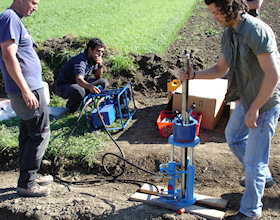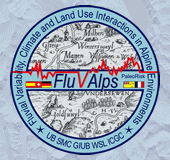Aims of research

Figure 3: Recovery of a sediment core from the Lombach fan delta (Berner Oberland, Switzerland; 21.09.2007, © by N. Moreno).
FluVAlps aims at the reconstruction of the past 3000 years of Alpine fluvial environments using high- and medium-resolution proxy data from fan delta deposits, pollen records and documentary sources. FluVAlps addresses the influence of external factors, such as climatic variability and land use, on aggradation processes and paleofloods in alpine catchments.
Currently the significance of flood magnitude, frequency and causes in mountain regions are discussed in the context of Global Change. After the 2005 Lütschine flood event these variables are discussed once more on a local scale. From a Holocene perspective, we highlight the following key points:
- Can fan delta deposits in the Alps provide high-resolution paleoclimate proxies? And if so, how do these natural archives correlate with local, regional and global climate variability? Exist an synchronous or asynchronous response of different Alpine catchments? Attention will be paid particularly to climate phases as e.g. the maximum and minimum solar anomalies. Regarding the characterization of post LIA climate change, a special relevance is attributed to the environmental conditions recorded during warmer climate phases as the Medieval Warm Period and the Roman Climate Optimum.
- To which extend did land uses modify the environment and geomorphic processes in the catchments? Are there significant changes in flood magnitude or frequency before and after the shift from natural dominated to human dominated ecosystems?
- Concerning a mayor accuracy of past discharge models and future flood scenarios, the understanding of timing of mayor floods (during cooler or warmer or transitional Holocene periods), is as crucial as the cross calibration of natural archives, written sources and instrumental flood records. From the calibration the question emerges which were the mayor controlling mechanisms of floods and aggradation processes in the past. The improvement of this knowledge will provide a good starting point to test flood models and to assess natural hazards in Alpine catchments.
Schulte, L. et al. 2019.
Integration of multi-archive datasets towards the development of a four-dimensional paleoflood model in alpine catchments.
Global and Planetary Change 180, 66-88.
Peña, J.C.; Schulte, L., 2020.
Simulated and reconstructed atmospheric variability and their relation with large Pre-industrial summer floods in the Hasli-Aare catchment (Swiss Alps) since 1300 CE.
Global and Planetary Change 190, 103191.
Schulte, L. et al., 2019.
Pluridisciplinary analysis and multi-archive reconstruction of paleofloods: societal demand, challenges and progress.
Global and Planetary Change 177, 225-238.
Blöschl, G. et al. 2020.
Current European flood-rich period exceptional compared with past 500 years.
Sánchez-García et al. 2019.
500-year flood history in the arid environments of south-eastern Spain. The case of the Almanzora River.
Global and Planetary Change, 102987.
Schulte, L. et al. 2015.
A 2600-year history of floods in the Bernese Alps, Switzerland: frequencies, mechanisms and climate forcing.
Hydrology and Earth System Sciences 19, 3047-3072.
Peña, J.C. et al. 2015.
Influence of solar forcing, climate variability and atmospheric circulation patterns on summer floods in Switzerland.





